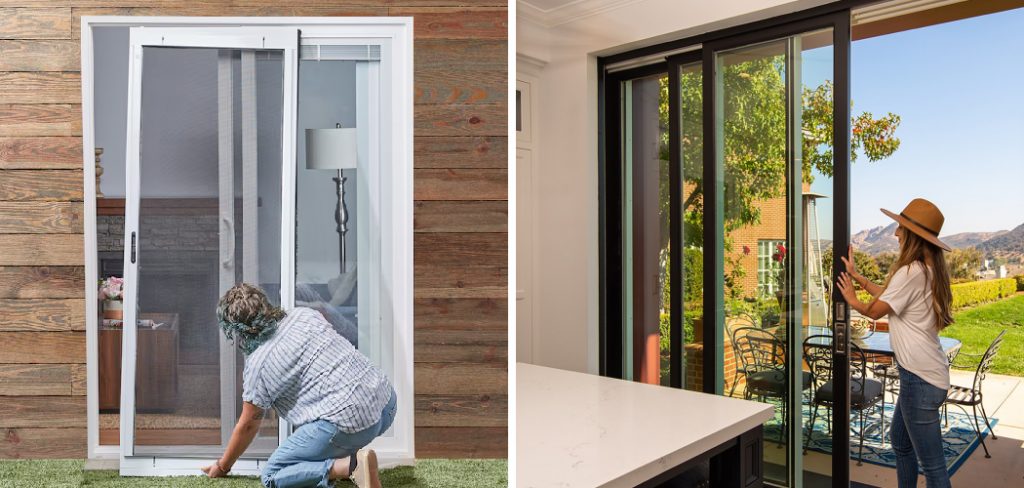Accurate measurements are crucial for the successful installation of a sliding glass door. Incorrect measurements can lead to various issues, such as drafts, improper sealing, and difficulties in indoor operation. To avoid these problems, precise measuring techniques must be employed from the start. Before beginning the measurement process, it is essential to understand the types of sliding glass doors available, gather the necessary tools, and account for any structural nuances of the installation site.

This article will provide a comprehensive guide on how to measure for sliding glass door, covering every aspect, from understanding the rough opening and determining the door size to checking for squareness and documenting measurements. Following each step meticulously will ensure a proper fit and smooth installation process for your sliding glass door.
Understanding Types of Sliding Glass Doors
Sliding glass doors come in various styles, each suited for different needs and aesthetics. The standard sliding glass door consists of two panels, one fixed and one sliding, offering a space-saving solution with a wide opening. Patio sliding doors, often used to connect indoor spaces with patios or gardens, are similar but typically larger, providing more natural light and an expansive view. French sliding doors combine the elegance of traditional French doors with the functionality of sliding mechanisms, often featuring multiple panes of glass for a sophisticated look.
When choosing the right type of sliding glass door for your space, consider factors such as the available opening size, desired functionality, and the architectural style of your home. Smaller spaces might benefit from standard sliding doors, whereas larger openings could be ideal for patio or French sliding doors. Additionally, consider energy efficiency, security features, and the material of the door frames, such as aluminum, wood, or vinyl.

Standard dimensions for sliding glass doors typically range from 60 to 72 inches in width and 80 inches in height. However, customization options are available to match unique architectural requirements or personal preferences. Custom doors can be designed to fit non-standard openings, incorporate special glazing options, and match specific design aesthetics, ensuring a perfect fit for your home’s needs.
Tools Needed for Measurement
You’ll need several essential tools to accurately measure for a sliding glass door. Begin with measuring tape to determine dimensions and a pencil to record measurements. A level is crucial to ensure your measurements are accurate and the surfaces are even. Utilize a step ladder to safely reach higher spots. Optional tools that can enhance precision include a digital caliper for exact measurements and a laser measurer for quickly determining distance. These tools will help streamline the measurement process and ensure the accuracy required for a successful sliding glass door installation.
How to Measure for Sliding Glass Door: Measuring the Rough Opening
Accurate measurement of the rough opening is crucial for properly fitting your sliding glass door. Start by measuring the width of the opening. To do this, use your measuring tape to measure from stud to stud at three points: across the opening’s top, middle, and bottom. Record each measurement. It’s essential to take these multiple measurements as walls can sometimes bow, causing variations in width.
Next, measure the height of the rough opening. Begin at the left side of the opening and measure from the floor to the header. Repeat this process in the center and right of the opening. Record each of these height measurements. Similar to the width, measuring at multiple points is important to account for any irregularities in the floor or header.
After you’ve noted all your measurements, identify the smallest width and height values. These smallest measurements will be the most accurate representations of your rough opening and should be used to determine the appropriate door size. Using the smallest numbers ensures the sliding glass door fits into the opening without undue stress or force during installation.
Carefully recording these measurements is crucial. Any discrepancies can lead to a poorly fitting door, resulting in drafts, water leakage, or difficulties opening and closing the door. By following these detailed steps and ensuring you use the smallest measurements, you’ll lay the groundwork for a precise and successful installation of your sliding glass door.

Determining Door Size and Configuration
Once you have the rough opening measurements, the next step is to determine the door size and configuration that will fit best. Start by calculating the door size based on the rough opening’s smallest width and height measurements. This will ensure the door can be installed without force, preventing future operational issues.
Consider the door frame width and jamb dimensions in your calculations. The door frame should be slightly smaller than the rough opening to accommodate shims and allow adjustments during installation. Typically, this means subtracting about 1/2 inch to 3/4 inch from the measurements of both the width and height to ensure a proper fit.
Next, decide on the door’s sliding direction. Most sliding glass doors have the sliding panel on either the left or right side. Choose the direction that best suits your room layout and traffic flow. For instance, if the space to the right of the opening is obstructed, a left-sliding door may be more practical.
Additionally, consider the number of panels for your sliding glass door. Standard configurations include two-panel doors with one fixed and one sliding panel, but options such as three or four-panel doors are available for larger openings. These can offer a wider view and easier access, making them ideal for expansive patio areas. Select the configuration that best complements your home’s architectural style and functional requirements.
Checking for Squareness and Level
Before proceeding with the installation, it is vital to check if your rough opening is square and level. Begin by using a level to inspect the floor and header. Place the level across the floor of the rough opening to ensure it’s level. Repeat this for the header. If either is uneven, note the discrepancy, as it may require shimming or additional adjustments during installation.
Next, ensure the sides of the rough opening are square by measuring diagonally from corner to corner. Measure from the top left corner to the bottom right corner and then from the top right corner to the bottom left corner. Both measurements should be identical. If they are not, this indicates that the opening is not square.

If the opening is not square or level, adjust your calculations based on the smallest measurement for width and height. You may need to make structural adjustments or use shims during installation to achieve a proper fit. Ensuring squareness and levelness at this stage is crucial for the smooth operation and proper sealing of your sliding glass door.
Considering Framing and Installation Requirements
Once you have verified the measurements and checked for squareness and levelness, the next step is to consider any framing or installation requirements that may be needed. Start by assessing whether the existing framing around the rough opening will support the weight and dimensions of the new sliding glass door. If the framing is inadequate or damaged, you may need to reinforce it with additional studs or headers before proceeding.
Consult the manufacturer’s installation guidelines to understand the specific framing requirements for your sliding glass door. These guidelines detail the necessary structural support and any additional framing adjustments required to ensure a stable installation. Follow these recommendations closely to avoid compromising the door’s functionality and durability.
Prepare the rough opening by ensuring that all surfaces are smooth and clean. Remove any debris, protruding nails, or old caulking that could interfere with the installation. If shimming is needed to correct any uneven surfaces, do so to create a flush and secure base for the door frame.
By carefully considering the framing and following the manufacturer’s instructions, you can ensure that the rough opening is properly prepared. This attention to detail will contribute to a successful and long-lasting installation of your sliding glass door.
Documenting and Double-Checking Measurements
Accurately documenting your measurements is crucial for successfully installing your sliding glass door. Start by recording each measurement on a detailed diagram or worksheet, labeling each dimension clearly. This visual reference will help prevent confusion during installation and allow you to quickly identify discrepancies.
Before proceeding, double-check all measurements for consistency and correctness. Re-measure the width and height at multiple points and compare these figures with your initial recordings. Minor errors can lead to significant issues during installation, so it’s essential to verify accuracy.

If you have any questions about your measurements, consult a professional or sliding glass door retailer. They can provide valuable insights and may offer measurement verification services. Accurate measurements ensure that your door fits perfectly and operates smoothly, preventing future problems such as drafts or misalignment. Taking these steps will help guarantee a successful and hassle-free installation.
Conclusion
In conclusion, understanding how to measure for sliding glass door installation is paramount to ensuring a smooth and effective setup. Precise measurements are the foundation of a successful installation, preventing issues such as misalignment, drafts, and operational difficulties. You establish a strong basis for the entire installation process by thoroughly documenting and double-checking your measurements.
Adhere to manufacturer guidelines and seek professional advice when necessary. These resources provide detailed instructions and insights to mitigate potential challenges and contribute to a durable, well-functioning door. Preparing your rough opening accurately, considering framing needs, and verifying squareness and levelness are all crucial steps for a hassle-free installation.
By focusing on these key areas and taking the time to prepare effectively, you can achieve a seamless installation that enhances your home’s functionality and aesthetic appeal.
About
Safety Fic is a distinguished figure in the world of Diy design, with a decade of expertise creating innovative and sustainable Diy solutions. His professional focus lies in merging traditional craftsmanship with modern manufacturing techniques, fostering designs that are both practical and environmentally conscious. As the author of diy, Safety Fic delves into the art and science of Safety Fic-making, inspiring artisans and industry professionals alike.
Education RMIT University
(Melbourne, Australia) Associate Degree in Design (Safety Fic) Focus on sustainable design, industry-driven projects, and practical craftsmanship. Gained hands-on experience with traditional and digital manufacturing tools, such as CAD and CNC software.
Nottingham Trent University
(United Kingdom) Bachelor’s in diyfastly.com and Product Design (Honors) Specialized in product design with a focus on blending creativity with production techniques. Participated in industry projects, working with companies like John Lewis and Vitsoe to gain real-world insights.
Publications and Impact
In diy, Safety Fic his insights on indoor design processes, materials, and strategies for efficient production. His writing bridges the gap between artisan knowledge and modern industry needs, making it a must-read for both budding designers and seasoned professionals.
